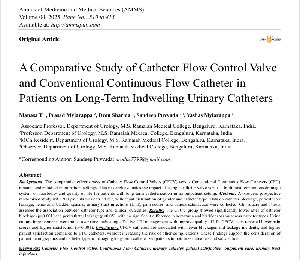A Comparative Study of Catheter Flow Control Valve and Conventional Continuous Flow Catheter in Patients on Long-Term Indwelling Urinary Catheters
Authors
##plugins.themes.bootstrap3.article.main##
Abstract
Background: The comparative effectiveness of Catheter Flow Control Valves (CFCV) versus Conventional Continuous Flow Catheters (CFC) remains understudied in outpatient settings. This research evaluates the impact of using a catheter valve versus a traditional continuous drainage system on morbidity and quality of life for patients with long-term catheterization in an outpatient setting. Methods: A one-year prospective randomized study with 200 patients was carried out, with equal distribution of gender and catheter type. Data on catheter blockage, pericatheter leakage, hematuria, bladder spasms, urinary tract infections (UTI), pain scores, and patient satisfaction were collected. Chi-square and T-tests assessed the association between catheter type and clinical outcomes. Results: The CFCV group showed significantly lower rates of catheter blockage (p=0.001) and pericatheter leakage (p<0.05), with no significant difference in hematuria and bladder spasms across catheter types. Urine culture improvements were noted over time, indicating effective UTI management with improve quality of life. CFCV users reported lower pain scores and higher satisfaction (p=0.001). Conclusion: CFCV catheters are associated with fewer blockages and leakage incidents, and higher patient satisfaction compared to CFC catheters, without increasing the risk of other complications. These findings support the consideration of patient demographics and catheter type in managing long-term catheterized patients to optimize outcomes and satisfaction.
##plugins.themes.bootstrap3.article.details##
Copyright (c) 2025 Manasa T, Prasad Mylarappa, Dron Sharma, Sandeep Puvvada, Yashas Mylarappa

This work is licensed under a Creative Commons Attribution 4.0 International License.
Creative Commons License All articles published in Annals of Medicine and Medical Sciences are licensed under a Creative Commons Attribution 4.0 International License.
Manasa T, Associate Professor, Department of Urology, M.S. Ramaiah Medical College, Bengaluru, Karnataka, India.
Associate Professor, Department of Urology, M.S. Ramaiah Medical College, Bengaluru, Karnataka, India.
Prasad Mylarappa, Professor, Department of Urology, M.S. Ramaiah Medical College, Bengaluru, Karnataka, India.
Professor, Department of Urology, M.S. Ramaiah Medical College, Bengaluru, Karnataka, India.
Dron Sharma, MCh Resident, Department of Urology, M.S. Ramaiah Medical College, Bengaluru, Karnataka, India.
MCh Resident, Department of Urology, M.S. Ramaiah Medical College, Bengaluru, Karnataka, India.
Sandeep Puvvada, Associate Professor, Department of Urology, M.S. Ramaiah Medical College, Bengaluru, Karnataka, India.
Associate Professor, Department of Urology, M.S. Ramaiah Medical College, Bengaluru, Karnataka, India.
Yashas Mylarappa, Observer, Department of Urology, M.S. Ramaiah Medical College, Bengaluru, Karnataka, India.
Observer, Department of Urology, M.S. Ramaiah Medical College, Bengaluru, Karnataka, India.
[1] Fanfani F, Costantini B, Mascilini F, Vizzielli G, et al. Early postoperative bladder training in patients submitted to radical hysterectomy: is it still necessary? A randomized trial. Arch Gynecol Obstet. 2015;291(4):883–8.
[2] Kandadai P, Duenas-Garcia OF, Pilzeck AL, et al. A randomized controlled trial of patient-controlled valve catheter and indwelling Foley catheter for short-term bladder drainage. Female PelvicMed Reconstruct Surg. 2016;22(2):88–92.
[3] Boyd SS, O'Sullivan DM, Tunitsky-Bitton E. A comparison of two methods of catheter management after pelvic reconstructive surgery: a randomized controlled trial. Obstet Gynecol. 2019;134(5): 1037–45.
[4] Sabih A, Leslie SW. Complicated urinary tract infections. InStatPearls [Internet] 2019 5. StatPearls Publishing.
[5] Feneley RC, Hopley IB, Wells PN. Urinary catheters: history, current status, adverse events and research agenda. Journal of medical engineering & technology. 2015 Nov 17;39(8):459-70.
[6] Medina‐Polo J, Salamanca AB, Ramallo Y,. A study protocol of a comparative mixed study of the T‐Control catheter. BJUI Compass. 2023.
[7] Dhariwal L, Chiu S, Salamon C. A urinary catheter valve is non-inferior to continuous bladder drainage with respect to post-operative UTIs: a randomized controlled trial. International Urogynecology Journal. 2021 Jun;32:1433-9.
[8] Holroyd S. Catheter valves: appropriate use and reduction of risk to bladder. Journal of Community Nursing. 2021 Oct 1;35(5).
[9] Ramallo‐Fariña Y, Chávarri AT, Robayna AA. Effectiveness of the T‐Control catheter: A study protocol. BJUI compass. 2023 Dec 4.
[10] Kranz J, Schmidt S, Wagenlehner F, Schneidewind L. Catheter-associated urinary tract infections in adult patients: Preventive strategies and treatment options. Deutsches Ärzteblatt International. 2020 Feb;117(6):83.
[11] Belfield K, Betts H, Parkinson R, Bayston R. A tolerability and patient acceptability pilot study of a novel antimicrobial urinary catheter for long‐term use. Neurourology and Urodynamics. 2019 Jan;38(1):338-45.
[12] Gad MH, AbdelAziz HH, Gad M. Catheter-associated urinary tract infections in the adult patient group: a qualitative systematic review on the adopted preventative and interventional protocols from the literature. Cureus. 2021 Jul 9;13(7).
[13] Ramstedt M, Ribeiro IA, Bujdakova H, Mergulhão FJ, Evaluating efficacy of antimicrobial and antifouling materials for urinary tract medical devices: Challenges and recommendations. Macromolecular bioscience. 2019 May;19(5):1800384.
[14] Abdel-Fattah, Mohamed, Diana Johnson, et al. "Randomised controlled trial comparing the clinical and cost-effectiveness of various washout policies versus no washout policy in preventing catheter associated complications in adults living with long-term catheters: study protocol for the CATHETER II study." Trials 23, no. 1 (2022): 630.
[15] Bonkat G, Bartoletti R, Bruyere F, Cai T, Geerlings SE, Köves B, et al. EAU Guidelines on Urological Infections. In: Office EG, editor.: EAU Guidelines Office, Arnhem, The Netherlands; 2020. p. 1–78.

